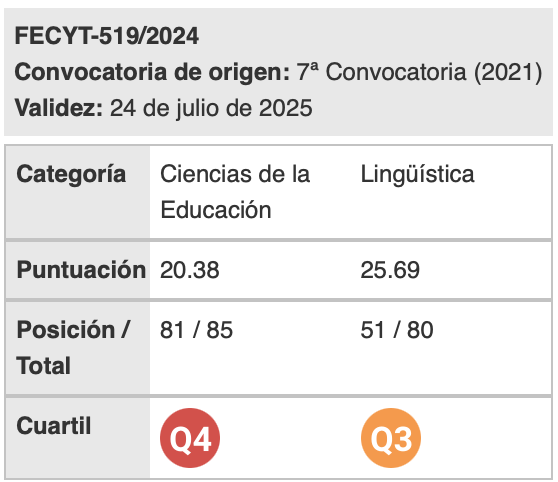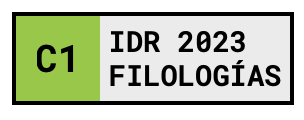Active subtitling in the classroom: a case study of an educational intervention
Keywords:
English for Specific Purposes, subtitling, audiovisual translation, oral comprehension, didactic unitAbstract
The objective of this article is to show the potential of the application of audiovisual translation, in particular of the modality of subtitling, for the development of oral comprehension, as well as its possible use as the backbone for the design of didactic units for the teaching of English for Specific Purposes (ESP). While it is true that a lot of progress has been made thanks to extensive research and the fact that numerous hypotheses have been confirmed regarding the benefits of the use of audiovisual translation in language teaching at a general level, research on the possibilities that audiovisual translation in language teaching for specific purposes can offer is still scarce. This is why this article also aims to contribute to this line of research by adding to previous studies carried out on the specialities of business English by Talaván (2006) and Ávila-Cabrera (2021) or military English by Fuentes-Luque and Campbell (2020). After providing a theoretical framework and critical review of the current literature, the study of an experimental case based on a didactic unit is presented. The didactic unit created as part of a national research project where the benefits of the use of the different modalities of audiovisual translation in language teaching has been put into practice within a technical English subject for this study. There is a comparative analysis between the results obtained in an experimental group and a control group after the implementation of a didactic unit that sought to work on the socializing function of language. The didactic unit designed is conceived for use in both face-to-face and virtual teaching environments and, in this particular case, and due to health restrictions, it has been developed in the online class format. The study will also raise the viability of implementing teaching units based on audiovisual translation as an alternative to those designed with a communicative approach but that still do not incorporate resources that are far from the conventional ones.
Downloads
References
Ávila-Cabrera, J. J. (2021). Reverse subtitling in the ESP class to improve written skills in English. A case study. Journal of Audiovisual Translation, 4(1), 27-49.
Ávila-Cabrera, J. J. (2022). Improving oral production skills in the Business English class through creative dubbing. ESP Today. Journal of English for Specific Purposes at Tertiary Level 10(1), 99-122. https://doi.org/10.18485/esptoday.2022.10.1.5
Ávila-Cabrera, J. J. & A. Corral Esteban. (2021). The project SubESPSKills: Subtitling tasks for students of Business English to improve written production skills. English for Specific Purposes, 63, 3-44. https://doi.org/10.1016/j.esp.2021.02.004
Ávila-Cabrera, J. J. & P. Rodríguez-Arancón. (2021). The use of active subtitling activities for students of Tourism in order to improve their English writing production. Ibérica: Revista de la Asociación Europea de Lenguas para Fines Específicos 41, 155-180. www.aelfe.org/documents/41_07_IBERICA.pdf
Baños, R. (2020). Fandubbing. En L. Bogucki & M. Deckert (eds), The Palgrave Handbook of Audiovisual Translation and Media Accessibility (pp. 209-226). Basingstoke: Palgrave Macmillan.
Bolaños García-Escribano, A. (2017). The effects of fansubs on EFL education for Translation and Interpreting students: An empirical approach. Journal of Specialised Translation, 28, 123–164.
Chaume, F. (2018). An overview of audiovisual translation: Four methodological turns in a mature discipline. Journal of Audiovisual Translation, 1(1), 40-63.
Chaume, F. (2020). Audiovisual Translation: Dubbing. Londres: Routledge.
Chiaro, D. (2017). The Language of Jokes in the Digital Age. Londres: Routledge.
Cerezo Merchán, B. 2018. Audiovisual Translation training. En L. Pérez González (ed.), Routledge Handbook of Audiovisual Translation (pp.468-482). Londres: Routledge.
Couto-Cantero, P., M. Sabaté-Carrové & M. C. Gómez Pérez. (2021). Preliminary design of an Initial Test of Integrated Skills within TRADILEX: An ongoing project on the validity of audiovisual translation tools in teaching English. Research in Education and Learning Innovation Archives, 27, 73-88. 10.7203/realia.27.20634
De Marco, M. (2012). Audiovisual Translation through a Gender Lens. Ámsterdam: Brill.
De Marco, M. (2016). The ‘engendering’approach in audiovisual translation. Target, 28(2), 314-325.
Díaz Cintas, J. (2004). In search of a theoretical framework for the study of audiovisual translation. En P. Orero (ed.), Topics in Audiovisual Translation (pp. 21-34). Ámsterdam: John Benjamins.
Díaz Cintas, J. (2009). New Trends in Audiovisual Translation. Bristol: Multilingual Matters.
Díaz Cintas, J. (2012). Clearing the smoke to see the screen: Ideological manipulation in audiovisual translation. Meta, 57(2), 279-293.
Díaz Cintas, J. & A. Remael. (2021). Subtitling. Concepts and Practices. Londres: Routledge.
Díaz-Cintas, J. & P. Muñoz-Sánchez. (2006). Fansubs: Audiovisual Translation in an amateur environment. Journal of Specialised Translation, 6, 37-52.
Fernández-Costales, A. (2012). Collaborative translation revisited: Exploring the rationale and the motivation for volunteer translation. FORUM. Revue internationale d’interprétation et de traduction, 10(1), 115-142.
Fernández-Costales, A. (2021a). Subtitling and dubbing as teaching resources in CLIL in Primary Education: The teachers’ perspective. Porta Linguarum, 36, 175-192. https://revistaseug.ugr.es/index.php/portalin/article/view/16228
Fernández-Costales, A. (2021b). Audiovisual translation in primary education. Students’ perceptions of the didactic possibilities of subtitling and dubbing in foreign language learning. Meta, 66(2), 280-300. DOI: https://doi.org/10.7202/1083179ar
Fuentes-Luque, A., & A. P. Campbell. (2020). Using subtitling to improve military ESP listening comprehension: An experimental study. Ibérica, 40, 245-266.
González-Vera, P. (2021). Building bridges between audiovisual translation and English for Specific Purposes. Ibérica, 41, 83-102. www.aelfe.org/documents/41_04_IBERICA.pdf
González-Vera, P. & A. Hornero-Corisco. (2019). Audiovisual materials: A way to reinforce listening skills in primary school teacher education. Language Value, 8, 1-25.
Gottlieb, H. (1992). Subtitling - a new university discipline. Teaching translation and interpreting. En C. Dollerup & A. Loddegaard (eds) Teaching Translation and Interpreting: Training, Talent and Experience (pp. 161–170). Ámsterdam: John Benjamins.
Hornero Corisco, A. M. & P. González-Vera. (2020). Audiovisual translation tools for the assessment of hard of hearing students. Language Value, 13, 58-77. https://doi.org/10.6035/LanguageV.2020.13.3
Ibáñez, A. & A. Vermeulen. (2015). Using VISP (VIdeos for SPeaking), a mobile app based on audio description, to promote English language learning among Spanish students: A case study. Procedia - Social and Behavioral Sciences, 178, 132-138. https://doi.org/10.1016/j.sbspro.2015.03.169.
Ibáñez, A., A. Vermeulen & M. Jordano. (2016). Using audio description to improve FLL students’ oral competence in MALL: methodological preliminaries. En A. Pareja-Lora, C. Calle-Martínez, & P. Rodríguez-Arancón (eds), New Perspectives on Teaching and Working with Languages in the Digital Era (pp. 245–156). Dublin: Research-Publishing.net. https://doi.org/10.1016/0732-118X(86)90008-5.
Incalcaterra McLoughlin, L. & J. Lertola. (2011). Learn through subtitling: Subtitling as an aid to language learning. En L. Incalcaterra McLoughlin, M. Biscio & M. Á. Ní Mhainnín (eds), Audiovisual Translation: Subtitles and Subtitling. Theory and Practice (pp. 243–263). Oxford: Perter Lang.
Incalcaterra, L., J. Lertola & N. Talaván. (2018). Editorial. Translation and Translanguaging in Multilingual Contexts, 4(1), 1–9. https://doi.org/10.1075/ttmc.00001.edi
Incalcaterra McLoughlin, L., J. Lertola & N. Talavan (eds). (2020). Audiovisual Translation in Applied Linguistics: Educational Perspectives. Ámsterdam: John Benjamins. https://doi.org/10.1075/bct.111
Krashen, S. (1982). Principles and Practice in Second Language Acquisition. Oxford: Pergamon
Lertola, J. (2012). The effect of the subtitling task on vocabulary learning. En A. Pym & D. Orrego-Carmona (eds), Translation Research Projects 4 (pp. 61–70). Tarragona: Universitat Rovira i Virgili. www.intercultural.urv.cat/media/upload/domain_317/arxius/TP4/5-Lertola.pdf.
Lertola, J. (2018). From translation to audiovisual translation in foreign language learning. Trans. Revista de Traductología, 22, 185-202. https://doi.org/10.24310/trans.2018.v0i22.3217.
Lertola, J. (2019). Audiovisual Translation in the Foreign Language Classroom: Applications in the Teaching of English and Other Foreign Languages. Voillons: Researchpublishing.net. https://doi.org/10.14705/rpnet.2019.27.9782490057252
Martínez Sierra, J. J. (2020). Audio describing humour: Seeking laughter when images do not suffice. En M. Dore (ed.), Humour Translation in the Age of Multimedia (pp. 177-195). Londres: Routledge.
Montero Pérez, M., W. Van Den Noortgate & P. Desmet. (2013). Captioned video for L2 listening and vocabulary learning: A meta-analysis. System, 41(3), 720-739. https://doi.org/10.1016/j.system.2013.07.013.
Orrego, D. (2013). Avance de la traducción audiovisual: desde los inicios hasta la era digital. Mutatis Mutandis. Revista Latinoamericana de Traducción, 6(2), 297-320.
Pedersen, J. (2011) Subtitling Norms for Television. Ámsterdam: John Benjamins.
Ramière, N. (2006). Reaching a foreign audience: Cultural transfers in audiovisual translation. Journal of Specialised Translation, 6, 152-166.
Sánchez-Requena, A. (2018). Intralingual dubbing as a tool for developing speaking skills. Special issue of translation and translanguaging in multilingual contexts. Audiovisual Translation in Applied Linguistics: Educational Perspectives, 4(1), 102–128. https://doi.org/10.1075/ttmc.00006.san
Suárez, M. del M. & F. Gesa. (2019). Learning vocabulary with the support of sustained exposure to captioned video: do proficiency and aptitude make a difference? Language Learning Journal, 47(4), 497–517. https://doi.org/10.1080/09571736.2019.1617768.
Talaván, N. (2006). The technique of subtitling for business English communication. RLFE. Revista de Lenguas Para Fines Específicos, 11(12), 313-346.
Talaván, N. (2011). A quasi-experimental research project on subtitling and foreign language acquisition. En L. Incalcaterra McLoughlin, M. Biscio & M. Á. Ní Mhainnín (eds), Subtitles and Subtitling. Theory and Practice (pp. 197–218). Oxford: Peter Lang. https://doi.org/https://doi.org/10.3726/978-3-0353-0167-0.
Talaván, N. (2013). La subtitulación en el aprendizaje de lenguas extranjeras. Barcelona: Octaedro. https://www.octaedro.com/appl/botiga/client/img/10137.pdf.
Talaván, N. (2019a). Creative audiovisual translation applied to foreign language education: a preliminary approach. Journal of Audiovisual Translation, 2(1), 53-74.
Talaván, N. (2019b). Using subtitles for the deaf and hard of hearing as an innovative pedagogical tool in the language class. International Journal of English Studies, 19(1), 21-40. https://doi.org/https://doi.org/10.6018/ijes.338671.
Talaván, N. (2020). The didactic value of AVT in foreign language education. En L. Bogucki & M. Deckert (eds), The Palgrave Handbook of Audiovisual Translation and Media Accessibility, (pp. 567–592). Basingstoke: Palgrave Macmillan.
Talaván, N. (2021). Las voces superpuestas: Fundamentos y aplicaciones didácticas. En C. Botella & B. Agulló (eds), Mujeres en la traducción audiovisual. Perspectivas desde el mundo académico y profesional (pp. 69–90). Madrid: Sindéresis.
Talaván, N., A. Ibáñez & E. Bárcena. (2017). Exploring collaborative reverse subtitling for the enhancement of written production activities in English as a second language. ReCALL, 29(1), 39-58. https://doi.org/10.1017/S0958344016000197.
Talaván, N. & J. Lertola. (2022). Audiovisual translation as a didactic resource in foreign language education. A methodological proposal. Encuentro: Revista de Investigación e Innovación en la Clase de Idiomas, 30, 3–18. www3.uah.es/encuentrojournal/index.php/encuentro/article/view/66
Talaván, N., J. Lertola & A. Ibañez Moreno. (2022). Audio description and subtitling for the deaf and hard of hearing. Media accessibilitiy in foreign language learning. Translation and Translanguaging in Multilingual Contexts, 8(1), 1-29. https://doi.org/10.1075/ttmc.00082.tal |
Vanderplank, R. (1988). The value of teletext sub-titles in language learning. ELT Journal, 42(4), 272–281.
Vanderplank, R. (2016). “Effects of” and “effects with” captions: How exactly does watching a TV programme with same-language subtitles make a difference to language learners? Language Teaching, 49(2), 235–250. https://doi.org/10.1017/S0261444813000207
Winke, P., S. Gass & T. Sydorenko. (2010). The effect of captioning videos used for foreign language listening activities. Language Learning & Technology, 14(1), 65-86. http://llt.msu.edu/vol14num1/winkegasssydorenko.pdf.
Zabalbeascoa, P. (2020). The role of humour in AVT: AVHT. En L. Bogucki & M. Deckert (eds), The Palgrave Handbook of Audiovisual Translation and Media Accessibility (pp. 667–686). Basingstoke: Palgrave Macmillan. https://doi.org/10.1007/978-3-030-42105-2_32.
Downloads
Published
How to Cite
Issue
Section
License
Authors who publish with this journal agree to the following terms:
- Authors retain copyright and grant the journal right of first publication with the work simultaneously licensed under a Creative Commons Attribution License that allows others to share the work with an acknowledgement of the work's authorship and initial publication in this journal.
- Authors are able to enter into separate, additional contractual arrangements for the non-exclusive distribution of the journal's published version of the work (e.g., post it to an institutional repository or publish it in a book), with an acknowledgement of its initial publication in this journal.
- Authors are permitted and encouraged to post their work online (e.g., in institutional repositories or on their website) prior to and during the submission process, as it can lead to productive exchanges, as well as earlier and greater citation of published work (See The Effect of Open Access).

Revista de Lenguas para fines específicos is licensed under a Creative Commons Reconocimiento-NoComercial-SinObraDerivada 4.0 Internacional License.

























